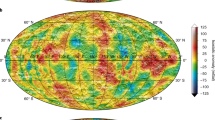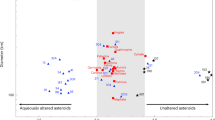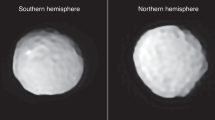Abstract
Remote observations of the asteroid (1) Ceres from ground- and space-based telescopes have provided its approximate density and shape, leading to a range of models for the interior of Ceres, from homogeneous to fully differentiated1,2,3,4,5,6. A previously missing parameter that can place a strong constraint on the interior of Ceres is its moment of inertia, which requires the measurement of its gravitational variation1,7 together with either precession rate8,9 or a validated assumption of hydrostatic equilibrium10. However, Earth-based remote observations cannot measure gravity variations and the magnitude of the precession rate is too small to be detected9. Here we report gravity and shape measurements of Ceres obtained from the Dawn spacecraft, showing that it is in hydrostatic equilibrium with its inferred normalized mean moment of inertia of 0.37. These data show that Ceres is a partially differentiated body, with a rocky core overlaid by a volatile-rich shell, as predicted in some studies1,4,6. Furthermore, we show that the gravity signal is strongly suppressed compared to that predicted by the topographic variation. This indicates that Ceres is isostatically compensated11, such that topographic highs are supported by displacement of a denser interior. In contrast to the asteroid (4) Vesta8,12, this strong compensation points to the presence of a lower-viscosity layer at depth, probably reflecting a thermal rather than compositional gradient1,4. To further investigate the interior structure, we assume a two-layer model for the interior of Ceres with a core density of 2,460–2,900 kilograms per cubic metre (that is, composed of CI and CM chondrites13), which yields an outer-shell thickness of 70–190 kilometres. The density of this outer shell is 1,680–1,950 kilograms per cubic metre, indicating a mixture of volatiles and denser materials such as silicates and salts14. Although the gravity and shape data confirm that the interior of Ceres evolved thermally1,4,6, its partially differentiated interior indicates an evolution more complex than has been envisioned for mid-sized (less than 1,000 kilometres across) ice-rich rocky bodies.
This is a preview of subscription content, access via your institution
Access options
Subscribe to this journal
Receive 51 print issues and online access
$199.00 per year
only $3.90 per issue
Buy this article
- Purchase on Springer Link
- Instant access to full article PDF
Prices may be subject to local taxes which are calculated during checkout



Similar content being viewed by others
References
McCord, T. B. & Sotin, C. Ceres: evolution and current state. Geophys. Res. Lett. 110, E05009 (2005)
Thomas, P. C. et al. Differentiation of the asteroid Ceres as revealed by its shape. Nature 437, 224–226 (2005)
Zolotov, M. Y. On the composition and differentiation of Ceres. Icarus 204, 183–193 (2009)
Castillo-Rogez, J. C. & McCord, T. B. Ceres’ evolution and present state constrained by shape data. Icarus 205, 443–459 (2010)
Castillo-Rogez, J. C. Ceres—neither a porous nor salty ball. Icarus 215, 599–602 (2011)
Neveu, M. & Desch, S. J. Geochemistry, thermal evolution, and cryovolcanism on Ceres with a muddy ice mantle. Geophys. Res. Lett. 42, 10,197–10,206 (2015)
Heiskanen, W. A. & Moritz, H. Physical Geodesy (W. H. Freeman and Company, 1967)
Konopliv, A. S. et al. The Vesta gravity field, spin pole and rotation period, landmark positions, and ephemeris from the Dawn tracking and optical data. Icarus 240, 103–117 (2014)
Rambaux, N. et al. Third-order development of shape, gravity, and moment of inertia for highly celestial bodies. Application to Ceres. Astron. Astrophys. 584, A127 (2015)
Anderson, J. D. et al. Gravitational constraints on the internal structure of Ganymede. Nature 384, 541–543 (1996)
Kucinskas, A. B. & Turcotte, D. L. Isostatic compensation of equatorial highlands on Venus. Icarus 112, 104–116 (1994)
Bills, B. G. et al. Harmonic and statistical analyses of the gravity and topography of Vesta. Icarus 240, 161–173 (2014)
Consolmagno, G. J. et al. The significance of meteorite density and porosity. Chem. Erde 68, 1–29 (2008)
De Sanctis, M. C. et al. Ammoniated phyllosilicates with a likely outer Solar System origin on (1) Ceres. Nature 528, 241–244 (2015)
Russell, C. T. et al. Dawn arrives at Ceres: exploration of a small volatile-rich world. Science (in the press)
Gaskell, R. W. et al. Characterizing and navigating small bodies with imaging data. Meteorit. Planet. Sci. 43, 1049–1061 (2008)
Preusker, F. et al. Shape model, reference system definition, and cartographic mapping standards for comet 67P/Churyumov-Gerasimenko—stereo-photogrammetric analysis of Rosetta/OSIRIS image data. Astron. Astrophys. 583, A33 (2015)
Peale, S. J. Excitation and relaxation of the wobble, precession, and libration of the Moon. J. Geophys. Res. 81, 1813–1827 (1976)
Rambaux, N. et al. Constraining Ceres’ interior from its rotational motion. Astron. Astrophys. 535, A43 (2011)
Buczkowski, D. et al. The geomorphology of Ceres. Science (in the press)
Hiesinger, H. et al. Cratering on Ceres: implications for its crust and evolution. Science (in the press)
Ruesch, O. et al. Cryovolcanism on Ceres. Science (in the press)
Radau, R. Sur la loi des densités a l’intérieur de la Terre. Compt. Rend. 100, 972–974 (1885)
Darwin, G. H. The theory of the figure of the Earth carried to the second order of small quantities. Mon. Not. R. Astron. Soc. 60, 82–124 (1900)
Showman, A. P. & Malhotra, R. The Galilean satellites. Science 286, 77–84 (1999)
Iess, L. et al. Gravity field, shape, and moment of inertia of Titan. Science 327, 1367–1369 (2010)
Gao, Pa & Stevenson, D. J. Nonhydrostatic effects and the determination of icy satellite moments of inertia. Icarus 226, 1185–1191 (2013)
Kargel, J. S. et al. Europa’s crust and ocean: origin, composition, and the prospects for life. Icarus 148, 226–265 (2000)
Castillo-Rogez, J. C. & Young, E. Origin and evolution of volatile-rich asteroids. In Planetesimals: Early Differentiation and Consequences for Planets (eds Elkins-Tanton, L. & Weiss, B. ) Ch. 4 (Cambridge Univ. Press, in the press)
Nathues, A. et al. Sublimation in bright spots on (1) Ceres. Nature 528, 237–240 (2015)
Acknowledgements
This research was carried out in part at the Jet Propulsion Laboratory, California Institute of Technology, under a contract with the National Aeronautics and Space Administration. We thank the Dawn operations team for the development, cruise, orbital insertion and operations of the Dawn spacecraft at Ceres. R.S.P. thanks W. M. Folkner, E. M. Mazarico, and M. D. Rayman for comments and suggestions. N.R. is grateful to the CNU, Section 34, for supporting a six-month full-time research project through CRCT-2015 funding delivered by the MESR and acknowledges funding from the French National Programme of Planetology (PNP). M.J.T. acknowledges funding by the CNES. Government sponsorship acknowledged. All rights reserved.
Author information
Authors and Affiliations
Contributions
R.S.P., A.S.K. and A.T.V. performed data analysis and calibration. R.S.P., B.G.B., N.R., J.C.C.-R., C.A.R., A.I.E., M.T.Z., R.R.F., M.J.T., C.T.R., A.N. and F.P. contributed to the interpretation of the data. All authors contributed to the discussion of the results and to writing the paper.
Corresponding author
Ethics declarations
Competing interests
The authors declare no competing financial interests.
Additional information
The gravity science and framing camera data is available through the PDS Small Bodies Node website (http://sbn.pds.nasa.gov/data_sb/missions/dawn).
Extended data figures and tables
Extended Data Figure 1 Range of values for the degree-2 zonal gravity coefficient for Ceres.
We assume a two-layer model for Ceres and vary the density and radius of the core by solving Clairaut’s equations of rotational equilibrium at third order9. The best-fitting solution for J2 = 264.99 × 10−4 (blue line) is compared with the direct approach of Gao and Stevenson27 (red line), which generally shows a good agreement except at high core-density values. The white area at the upper right corresponds to solutions with shell density below 900 kg m−3.
Rights and permissions
About this article
Cite this article
Park, R., Konopliv, A., Bills, B. et al. A partially differentiated interior for (1) Ceres deduced from its gravity field and shape. Nature 537, 515–517 (2016). https://doi.org/10.1038/nature18955
Received:
Accepted:
Published:
Issue Date:
DOI: https://doi.org/10.1038/nature18955
This article is cited by
-
Observational evidence for cylindrically oriented zonal flows on Jupiter
Nature Astronomy (2023)
-
Geologically rapid aqueous mineral alteration at subfreezing temperatures in icy worlds
Nature Astronomy (2022)
-
Acquisition and Preservation of Remanent Magnetization in Carbonaceous Asteroids
Nature Astronomy (2022)
-
The Psyche Gravity Investigation
Space Science Reviews (2022)
-
The Psyche Topography and Geomorphology Investigation
Space Science Reviews (2022)
Comments
By submitting a comment you agree to abide by our Terms and Community Guidelines. If you find something abusive or that does not comply with our terms or guidelines please flag it as inappropriate.



